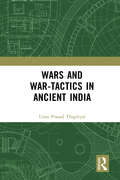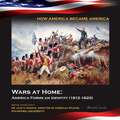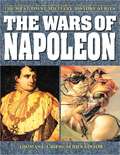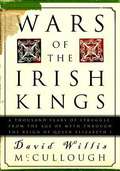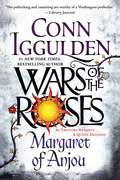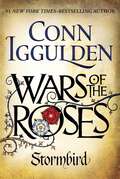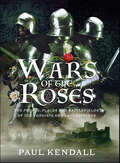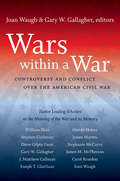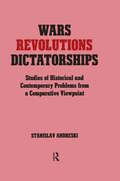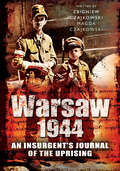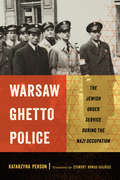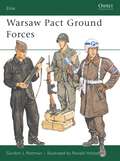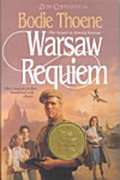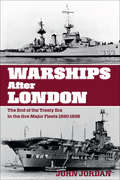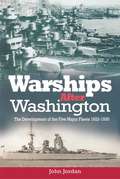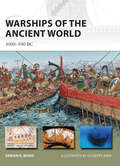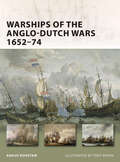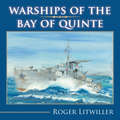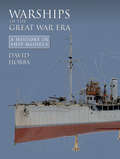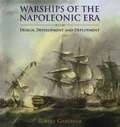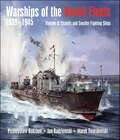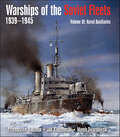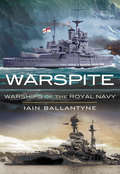- Table View
- List View
Wars and War-Tactics in Ancient India
by Uma Prasad ThapliyalThis work discusses the wars fought in ancient India and the war strategies that came to be developed. Advanced modes of combat were devised and new methods related to the use of various weapons were perfected. The volume also delves into The Mahābhārata and works like the Arthaśāstra, the Kāmandakīy Nītisāra and the Śukranīti that contain graphic descriptions of war tactics as these evolved over the centuries. Please note: Taylor & Francis does not sell or distribute the Hardback in India, Pakistan, Nepal, Bhutan, Bangladesh and Sri Lanka.
Wars at Home: America Forms an Identity (1812-1820) (How America Became America)
by Michelle QuinbyBy the beginning of the 1800s, America was a young country led by people who were ready to fight to defend American rights on the seas and at home. They were eager to teach Europe's older nations a lesson, and they wanted to add to America's land. America fought the War of 1812 as well as a war in Florida. The US came out of these wars stronger than ever-- and the people of the United States were ready for America to grow still bigger.
Wars of Napoleon
by Albert Sidney BrittThis fascinating study takes the reader from the early years of Napoleon's career to his defeat at Waterloo. It is a penetrating look at the technology, tactics, logistics, strategy, and outstanding generalship that created an empire.
Wars of the Irish Kings: A Thousand Years of Struggle from the Age of Myth Through the Reign of Queen Elizabeth I
by David Willis McculloughFor the first thousand years of its history, Ireland was shaped by its monasteries and its wars. The artistic flourishing of the monasteries has received a good deal of attention, but the violent and varied wars have in recent years gone unremembered. In Wars of the Irish Kings, David Willis McCullough has turned back to the earliest accounts of these struggles to present a rich tapestry of Ireland's fight for its identity. Beginning with the legends of ancient wars and warriors, moving through a time when history and storytelling were not separate crafts, into a time when history was as much propaganda as fact, Wars of the Irish Kings tells of tribal battles, foreign invasions, Viking raids, family feuds, wars between rival Irish kingdoms, and wars of rebellion against the English. This collection is peopled with familiar names: Cuchulain, Finn MacCool, Brian Boru, Mad King Sweeney, Strongbow, Edward and Robert Bruce, Queen Elizabeth I and Lord Essex, Hugh O'Donnell, and Hugh O'Neill. Battles formed the legends and history of the land: the Da Dannan meet the Fir Bolgs near Sligo, Brian Boru faces the Vikings at Clontarf in Dublin Bay, High King Rory O'Connor confronts the English invaders near Waterford, O'Briens battle the English (and other O'Briens) at Dysert O'Dea near Limerick, guns are carried for the first time in battle at Knockdoe near Galway, the Bruces from Scotland and their Irish allies overwhelm the English at Connor in Ulster, and Hugh O'Neill ambushes General Bagenal near Armagh. The book ends near Cork in 1601 when the English defeat O'Neill and his Spanish allies at Kinsale. Common people as well as kings appear in these pages. A foot soldier in the early days of gunpowder accidentally sets off a disastrous explosion, a harper's disembodied head is sent by error to the king of England, who displays it as that of the king of Ireland, and a Welsh camp follower named Alice is given the job of executing Irish captives during the English invasion. The sources for these stories and many more range from ancient manuscripts telling of mythical battles to a seventeenth-century siege diary. There are excerpts from such Irish literary masterpieces as The Cattle Raid of Cooley (The Tain), the monumental Annals of the Four Masters, passages from Gerald of Wales's account of the English conquest in the twelfth century, pages from an Icelandic saga, and even a blistering letter from Queen Elizabeth I to her inept commander in Ireland ("You do but piece up a hollow peace ..."). The result is a surprisingly immediate and stunning portrait of an all-but-forgotten time that forged the Ireland to come.
Wars of the Roses: Bloodline
by Conn IgguldenThe brilliant retelling of the Wars of the Roses continues with Bloodline, the gripping third novel in the new series from historical fiction master Conn Iggulden. Winter 1461: Richard, duke of York, is dead--his ambitions in ruins, his head spiked on the walls of the city. King Henry VI is still held prisoner. His Lancastrian queen, Margaret of Anjou, rides south with an army of victorious northerners, accompanied by painted warriors from the Scottish Highlands. With the death of York, Margaret and her army seem unstoppable. Yet in killing the father, Margaret has unleashed the sons. Edward of March, now duke of York, proclaims himself England's rightful king. Factions form and tear apart as snow falls. Through blood and treason, through broken men and vengeful women, brother shall confront brother, king shall face king. Two men can always claim a crown--but only one can keep it. Following Margaret of Anjou, Bloodline is the third epic installment in master storyteller Conn Iggulden's new Wars of the Roses series. Fans of the Game of Thrones and the Tudors series will be gripped from the word "go."From the Hardcover edition.
Wars of the Roses: Margaret of Anjou
by Conn IgguldenThe brilliant retelling of the Wars of the Roses continues with Margaret of Anjou, the second gripping novel in the new series from historical fiction master Conn Iggulden.As Traitors Advance...A Queen DefendsIt is 1454 and for over a year King Henry VI has remained all but exiled in Windsor Castle, struck down by his illness, his eyes vacant, his mind a blank. His fiercely loyal wife and Queen, Margaret of Anjou, safeguards her husband's interests, hoping that her son Edward will one day come to know his father.With each month that Henry is all but absent as king, Richard, the Duke of York, Protector of the Realm, extends his influence throughout the kingdom. The Trinity--Richard and the earls of Salisbury and Warwick--are a formidable trio, and together they seek to break the support of those who would raise their colors and their armies in the name of Henry and his Queen.But when the king unexpectedly recovers his senses and returns to London to reclaim his throne, the balance of power is once again plunged into turmoil. The clash of the Houses of Lancaster and York may be the beginning of a war that can tear England apart . . .Following on from Stormbird, Margaret of Anjou is the second epic installment in master storyteller Conn Iggulden's new Wars of the Roses series. Fans of Game of Thrones and The Tudors will be gripped from the word "go."
Wars of the Roses: Stormbird (Wars of the Roses #1)
by Conn Iggulden"Capturing the violence and romance of medieval life, Iggulden makes real those grand characters who live in the collective memory. A page-turner sure to have readers eager for the next in the series." --KirkusThe first book in #1 New York Times-bestselling author Conn Iggulden's brilliant new historical series about two families who plunged England into a devastating, decades-long civil war.In 1437, the Lancaster king Henry VI ascends the throne of England after years of semi-peaceful regency. Named "The Lamb," Henry is famed more for his gentle and pious nature than his father's famous battlefield exploits; already, his dependence on his closest men has stirred whispers of weakness at court. A secret truce negotiated with France to trade British territories for a royal bride--Margaret of Anjou--sparks revolts across English territory. The rival royal line, the House of York, sees the chaos brought on by Henry's weakness and with it not only opportunity in the monarch, but also their patriotic duty in ousting an ineffectual king. As storm clouds gather over England, King Henry and his supporters find themselves besieged abroad and at home. Who or what can save the kingdom before it is too late?
Wars of the Roses: The People, Places and Battlefields of the Yorkists and Lancastrians
by Paul KendallThe Wars of the Roses, which saw England and Wales ravaged by warfare for three decades and dynasties rise and fall, decimated the nobility of an entire generation, and saw the rise of the merchant class, the decline of medieval feudalism and opened the country to the enlightened ideals of the Renaissance. Such has been its lasting effects the red and white rose of the Tudors is still a national symbol. This book is an exploration of the buildings, monuments, towns and battlefields of that turbulent era across both England and Wales – places that can still be visited and experienced today. The stories of the great battles of St Albans, Stoke Field, Wakefield, Townton, Barnet, Tewksbury and, of course, Bosworth, are told along with beautiful photographs to help guide the reader round these important sites, as well as the dozens of smaller engagements where the supporters of the Houses of York and Lancaster fought and died. Here are castles and manor houses galore, all of which played their part in this protracted struggle for the throne of England, such as Richard of York’s imposing powerbase of Lulow Castle and the magnificent Tudor stronghold of Bamburg. These are compared with the scant remains of Fotheringhay Castle, the birthplace of Richard III – the man whose remains were so dramatically uncovered in Leicester – and Micklegate Bar, York, was where Richard’s head was placed on a spike. We see the Clocktower of St Albans and ‘Gabriel’ the bell that was rung in 1455 alerting of the Yorkist advance, as well as the Tower of London where Henry VI met his death and the possible burial place of the two princes. These, and scores of other places, monuments, plaques, buildings and battlegrounds, represent not only a journey across England and Wales, but a journey back in time to the bloody conflict that was the War of the Roses.
Wars within a War: Controversy and Conflict over the American Civil War
by Gary W. Gallagher Joan WaughComprised of essays from 12 leading scholars, this volume extends the discussion of Civil War controversies far past the death of the Confederacy in the spring of 1865. Contributors address, among other topics, Walt Whitman's poetry, the handling of the Union and Confederate dead, the treatment of disabled and destitute northern veterans, Ulysses S. Grant's imposing tomb, and Hollywood's long relationship with the Lost Cause narrative. The contributors are William Blair, Stephen Cushman, Drew Gilpin Faust, Gary W. Gallagher, J. Matthew Gallman, Joseph T. Glatthaar, Harold Holzer, James Marten, Stephanie McCurry, James M. McPherson, Carol Reardon, and Joan Waugh.
Wars, Revolutions and Dictatorships: Studies of Historical and Contemporary Problems from a Comparative Viewpoint
by Stanislav AndreskiFirst Published in 1992. Routledge is an imprint of Taylor & Francis, an informa company. We can define war as organised fighting between groups of individuals belonging to the same species but occupying distinct territories, thus distinguishing war from fights between isolated individuals as well as from struggles between groups living intermingled within the same territory, which can be classified as rebellions, revolutions, riots and so on.The articles included in this volume were written in the 1970s and 1980s and published in very diverse journals and proceedings of conferences, in one case only in German.
Warsaw 1944: An Insurgent's Journal of the Uprising
by Zbigniew Czajkowski&“Built around a journal written in the months just after the Warsaw uprising by . . . a teenage fighter in the Polish underground . . . a compelling account.&” —HistoryOfWar.org This remarkable journal, written shortly after the event, describes not only the author&’s own experiences of the 1944 Warsaw Uprising but the wider picture. With the Soviet Army&’s arrival imminent, the Polish Underground fighters decided to wage open warfare against the hated Nazi occupiers. This courageous decision was taken despite the Poles chronic shortage of arms, ammunition, and medical support. They fully expected the Soviets to relieve them gratefully for hastening the defeat of the Germans. With cruel and calculated cynicism, the Soviets halted their offensive and let the uneven match be settled without their involvement. The outcome was inevitable Warsaw was largely destroyed, the Polish men, women, and children fighters crushed and the Nazis weakened. The Soviets then moved in. This journal is a unique record of the bitter fighting when neither side was prepared to give quarter. &“Authentic, dramatically realistic, showing the tragedy of a generation thrown into a hopeless battle. A priceless treasure against which other memoirs pale in comparison.&” —Lech Dzikiewicz &“The author has described the scenes of fighting so vividly almost impossible to believe he had come out unscathed.&” —Kultura &“An exceptionally valuable document—great historical and literary value.&” —Dziennik Polski
Warsaw Ghetto Police: The Jewish Order Service during the Nazi Occupation
by Katarzyna PersonIn Warsaw Ghetto Police, Katarzyna Person shines a spotlight on the lawyers, engineers, young yeshiva graduates, and sons of connected businessmen who, in the autumn of 1940, joined the newly formed Jewish Order Service.Person tracks the everyday life of policemen as their involvement with the horrors of ghetto life gradually increased. Facing and engaging with brutality, corruption, and the degradation and humiliation of their own people, these policemen found it virtually impossible to exercise individual agency. While some saw the Jewish police as fellow victims, others viewed them as a more dangerous threat than the German occupation authorities; both were held responsible for the destruction of a historically important and thriving community. Person emphasizes the complexity of the situation, the policemen's place in the network of social life in the ghetto, and the difficulty behind the choices that they made. By placing the actions of the Jewish Order Service in historical context, she explores both the decisions that its members were forced to make and the consequences of those actions.Featuring testimonies of members of the Jewish Order Service, and of others who could see them as they themselves could not, Warsaw Ghetto Police brings these impossible situations to life. It also demonstrates how a community chooses to remember those whose allegiances did not seem clear.Published in Association with the US Holocaust Memorial Museum.
Warsaw Pact Ground Forces
by Gordon Rottman Ronald VolstadOsprey's study of the ground forces of the Cold War (1946-1991). While much has been published on the armed forces of the USSR during the 1980s, surprisingly little is available on the forces supplied by the other member nations of the Warsaw Pact. Rivalling the size of the United States Army, the combined ground forces of the six non-Soviet Warsaw Pact countries totalled over 775,000 active troops, with almost two million ground forces reserves. This book examines the history, organization and uniforms of the often overlooked DDR, Czechoslovak, Polish, Bulgarian, Hungarian and Romanian forces at the end of the Cold War.
Warsaw Requiem (The Zion Convent #6)
by Bodie Thoene Brock ThoeneThe compelling sequel to Danzig Passage, and the sixth book in the Zion Covenant Series, carrying on the life-and-death struggle to save Jewish children. Having overrun Czechoslavakia, German tanks now storm across the borders of Poland while Nazi planes bomb Warsaw into flames. Time is running out as the Nazis close in on the port of Danzig, point of escape for Jewish children.
Warships After London: The End of the Treaty Era in the Five Major Fleets, 1930–1936
by John JordanThe acclaimed naval historian presents an authoritative study of how the 1930 Treaty of London influenced warship design in the years before WW2. After the Washington Naval Treaty of 1922 put a cap on the construction of capital ships and aircraft carriers, the major navies of the world began building ‘treaty cruisers’ and other warships that maximized power while abiding the restrictions. As the French and Japanese excelled in this arena, Britain and the United States sought amendments that would curb their new cruisers, destroyers, and submarines. The negotiations which resulted in the Treaty of London of April 1930 were fraught, and the agreement proved controversial.Warships After London examines warship developments in the five major navies during the period 1930–1936. Long-term plans were disrupted, and new construction had to be reviewed in the light of the new treaty regulations. This led to new, often smaller designs, and a need to balance unit size against overall numbers within each of the categories.As ships produced under these restrictions were the newest available when war broke out in 1939, this book is a major contribution to understanding the nature of the navies involved. Its value is enhanced by well-chosen photographs and by the author’s original line drawings showing the ships’ overall layout, armament, protection, and propulsion.
Warships After London: The End of the Treaty Era in the Five Major Fleets, 1930–1936
by John JordanThe acclaimed naval historian presents an authoritative study of how the 1930 Treaty of London influenced warship design in the years before WW2. After the Washington Naval Treaty of 1922 put a cap on the construction of capital ships and aircraft carriers, the major navies of the world began building ‘treaty cruisers’ and other warships that maximized power while abiding the restrictions. As the French and Japanese excelled in this arena, Britain and the United States sought amendments that would curb their new cruisers, destroyers, and submarines. The negotiations which resulted in the Treaty of London of April 1930 were fraught, and the agreement proved controversial.Warships After London examines warship developments in the five major navies during the period 1930–1936. Long-term plans were disrupted, and new construction had to be reviewed in the light of the new treaty regulations. This led to new, often smaller designs, and a need to balance unit size against overall numbers within each of the categories.As ships produced under these restrictions were the newest available when war broke out in 1939, this book is a major contribution to understanding the nature of the navies involved. Its value is enhanced by well-chosen photographs and by the author’s original line drawings showing the ships’ overall layout, armament, protection, and propulsion.
Warships After Washington: The Development of Five Major Fleers, 1922–1930
by John JordanThis fascinating study of post-WWI naval powers reveals how international peace treaties influenced the design and engineering of modern warships. The Washington Naval Treaty of 1922 was designed to prevent an arms race between the major naval powers after the First World War. But the new constraint inspired ingenious attempts to maximize the power of ships built within the treaty&’s restrictions. By effectively banning the construction of new battleships for a decade, the signatories shifted their focus to the design and construction of large cruisers. In Warships After Washington, naval historian John Jordan examines the political and strategic background of the Washington Naval Treaty and the subsequent London Treaty of 1930. He then presents a detailed study of the types of warships built by the navies of Britain, the USA, Japan, France. The treaties influenced naval engineering across the board—from the development of capital ships and cruisers to super-destroyers, aircraft carriers, and large submarines.
Warships of the Ancient World
by Giuseppe Rava Adrian WoodThe world's first war machines were ships built two millennia before the dawn of the Classical world. Their influence on the course of history cannot be overstated. A wide variety of galleys and other types of warships were built by successive civilisations, each with their own distinctive appearance, capability and utility. The earliest of these were the Punt ships and the war galleys of Egypt which defeated the Sea People in the first known naval battle. Following the fall of these civilisations, the Phoenicians built biremes and other vessels, while in Greece the ships described in detail in the 'Trojan' epics established a tradition of warship building culminating in the pentekonters and triaconters. The warships of the period are abundantly illustrated on pottery and carved seals, and depicted in inscriptions and on bas-reliefs. The subject has been intensively studied for two and a half millennia, culminating in the contemporary works of authoritative scholars such as Morrison, Wallinga, Rodgers and Casson. To date there are no works covering the subject which are accessible and available to non-academics.
Warships of the Anglo-Dutch Wars 1652-1674
by Peter Bull Angus KonstamThree times during the 17th century, England and Holland went to war as part of an ongoing struggle for economic and naval supremacy. Primarily fought in the cold waters of the North Sea and the English Channel, the wars proved revolutionary in their impact upon warship design, armament, and naval tactics. During this time, the warship evolved into the true ship-of-the-line that would dominate naval warfare until the advent of steam power. This book traces the development of these warships in the context of the three Anglo-Dutch wars.
Warships of the Bay of Quinte
by Roger LitwillerThis is the story of six of Canadas Warships HMCS NAPANEE, HMCS BELLEVILLE, HMCS HALLOWELL, HMCS TRENTONIAN, HMCS QUINTE (I), and the HMCS QUINTE (II). These histories give a unique account of the small ships that have been the backbone of the Canadian Navy during the Second World War and the Cold War. The stories record the accomplishments of these hardworking ships as well as the mistakes. This rich and vivid account of an important part of Canadas Naval Service draws from the records of the ships, interviews with their crews, letters, diaries, newspaper articles, community libraries and photographs. You will learn about the HMCS NAPANEE as she fights a five day battle against twenty-four German submarines in on one of Canadas most tragic convoy battles. Be with HMCS BELLEVILLE as she fights to rescue a torpedoed merchant ship and find out about how a German submarine sinks the HMCS TRENTONIAN late in the war killing six of her crew.
Warships of the Great War Era: A History in Ship Models
by David HobbsThe National Maritime Museum in Greenwich houses the largest collection of scale ship models in the world, many of which are official, contemporary artefacts made by the craftsmen of the navy or the shipbuilders themselves, and ranging from the mid seventeenth century to the present day. As such they represent a three-dimensional archive of unique importance and authority. Treated as historical evidence, they offer more detail than even the best plans, and demonstrate exactly what the ships looked like in a way that even the finest marine painter could not achieve. This book is one of a series that takes a selection of the best models to tell the story of specific ship types in this case, the various classes of warship that fought in the First World War, from dreadnoughts to coastal motor boats. It reproduces a large number of model photos, all in full colour, and including many close-up and detail views. These are captioned in depth, but many are also annotated to focus attention on interesting or unusual features. Although pictorial in emphasis, the book weaves the pictures into an authoritative text, producing an unusual and attractive form of technical history.
Warships of the Napoleonic Era: Design, Development and Deployment (Blueprint Ser.)
by Robert GardinerA collection of British illustrations of their ships and ships they captured from 1793 to 1815, with informative text, by the author of The Sailing Frigate. Between 1793 and 1815, two decades of unrelenting naval warfare raised the sailing man-of-war to the zenith of its effectiveness as a weapon of war. Every significant sea power was involved in this conflict, and at some point virtually all of them were arrayed against Great Britain. Many enemy warships were captured in battle, making them of interest to British artists, engravers, and printmakers, while the Admiralty ordered accurate draughts to be made of many of these prizes. Consequently, for this era the ships of all navies, not just British, are illustrated by an unprecedented variety of paintings, drawings, models, or plans.Warships of the Napoleonic Era reproduces many of the best (and least familiar) images of the ships, chosen for their accuracy, detail, and sheer visual power in an extra-large format that does full justice to the images themselves. These are backed by an authoritative text that looks at how the ships were used by the different navies, and explains the function and development of the apparently bewildering array of rates and types. This is a book that anyone with an interest in wooden warships will find both enlightening and a pleasure to peruse.
Warships of the Soviet Fleets 1939–1945: Volume II: Escorts and Smaller Fighting Ships
by Przemyslaw Budzbon Jan RadziemskiSeventy-five years after the end of the Second World War the details of Soviet ships, their activities and fates remain an enigma to the West. In wartime such information was classified and after a brief period of glasnost (‘openness’) the Russian state has again restricted access to historical archives. Therefore, the value – and originality – of this work is difficult to exaggerate. It sees the first publication of reliable data on both the seagoing fleets and riverine flotillas of the Soviet Navy, listing over 6200 vessels from battleships to river gunboats, and mercantile conversions as well as purpose-built warships. This second part of the three-volume series includes all the remaining fighting vessels not already covered in Volume I. Beginning with the Uragan class – rated as Escort Ships and the first seagoing warships designed by the Soviet Union – the book then moves on to Submarine Hunters, both large and small, Patrol craft, Minelayers and Minesweepers, and unusual types like Floating Artillery Batteries and Anti-Aircraft Defense Ships, concluding with Landing Ships and Craft. Many of these vessels have hitherto been poorly documented but given the nature of the land-centered Soviet war against Germany their contribution should not be underestimated. The details of their service and, not least, the circumstances of their loss, constitute a major addition to Western understanding of the Soviet Navy’s war effort. This is undoubtedly one of the most important naval reference works of recent years and will be welcomed by anyone with an interest in warships, the Soviet Navy or wider maritime aspects of the Second World War. Furthermore, as recent Russian actions appear to revive Soviet-era aspirations, this book offers both new insights and valuable background of contemporary relevance.
Warships of the Soviet Fleets 1939–1945: Volume III: Naval Auxiliaries
by Przemyslaw Budzbon Jan Radziemski Marek TwardowskiSeventy-five years after the end of the Second World War the details of Soviet ships, their activities and fates remain an enigma to the West. In wartime such information was classified and after a brief period of glasnost (‘openness’) the Russian state has again restricted access to historical archives. Therefore, the value – and originality – of this work is difficult to exaggerate. It sees the first publication of reliable data on both the seagoing fleets and riverine flotillas of the Soviet Navy, listing over 6200 vessels from battleships to river gunboats, and mercantile conversions as well as purpose-built warships. This third and final part of the series includes all the ships in naval service that were not frontline fighting vessels. Despite auxiliary status, these were not insignificant ships – indeed the icebreakers were the largest vessels built by the USSR before the war and carried so much prestige that every leading member of the Soviet regime wanted their name on one. Apart from the obvious fleet support types – oilers, tugs and depot ships – this volume also covers unsung heroes like the salvage fleet, highly significant in the 1930s for generating much-needed foreign currency and later essential to the war effort, allowing so many sunken Soviet warships to be returned to service. Another major feature of this volume is the first clear and comprehensive listing of ex-mercantile transport ships, their periods of service and ultimate fates. Even harbor service craft are included, right down to the humble ‘heaters’ that supplied warmth to icebound warships in the depth of the Russian winters. This volume concludes with a number of important appendices on subjects like weaponry and a massive cross-referenced index that will allow readers to differentiate between ships of the same name and to track every name change. This is undoubtedly one of the most important naval reference works of recent years and will be welcomed by anyone with an interest in warships, the Soviet Navy or wider maritime aspects of the Second World War. Furthermore, as recent Russian actions appear to revive Soviet-era aspirations, this book offers both new insights and valuable background of contemporary relevance.
Warspite: Warships Of The Royal Navy
by Iain BallantyneNo warship name in British naval history has more battle honours than HMS Warspite. While this book looks at the lives of all eight vessels to bear the name (between 1596 and the 1990s), it concentrates on the truly epic story of the seventh vessel, a super-dreadnought battleship, conceived as the ultimate answer to German naval power, during the arms race that helped cause WW1. Warspite fought off the entire German fleet at Jutland, survived a mutiny between the wars and then covered herself in glory in action from the Arctic to the Indian Ocean during WW2. She was the flagship of Admiral Sir Andrew Cunningham when he mastered the Italian Navy in the Mediterranean, her guns inflicting devastating damage on the enemy at Calabria in 1940 and Matapan in 1941. She narrowly avoided destruction by the Japanese carrier force that had earlier devastated Pearl Harbor. She provided crucial fire support for Allied landings in Sicily, Italy, Normandy and Walcheren. A lucky ship in battle, she survived dive-bombers off Crete and glide bomb hits off Salerno. The Spite had a reputation for being obtuse at unexpected moments, running aground and losing her steering several times; she broke free from her towropes on the way to the breakers and ending up beached at St Michael's Mount where it took a decade to dismantle her. She had fought to the end.But this is not just the story of a warship. Wherever possible the voices of those men who fought aboard her speak directly to the reader about their experiences. Warspite is also the story of a great naval nation which constructed her as the ultimate symbol of its imperial power and then scrapped her when the sun set on that empire.About the AuthorIain Ballantyne is a much published naval author. His other books for Pen & Sword are HMS London, HMS Rodney and Victory as well as Strike From the Sea and Killing the Bismarck. He is editor of WARSHIPS IFR magazine. For more details on Iain Ballantyne and his books, visit: www.iainballantyne.com
